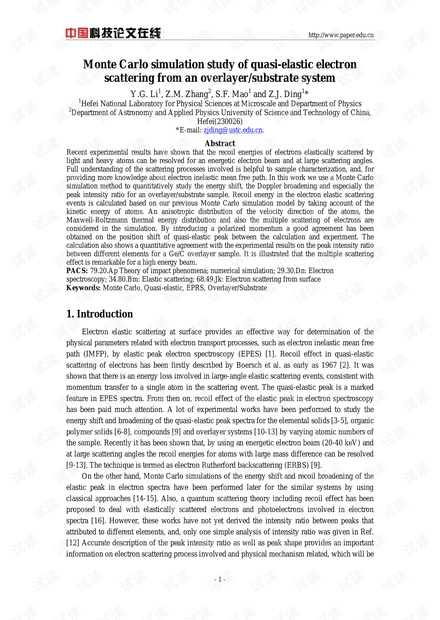没有合适的资源?快使用搜索试试~ 我知道了~
Monte Carlo simulation study of quasi-elastic electron scatterin...
0 下载量 145 浏览量
2020-03-14
14:24:30
上传
评论
收藏 1.12MB PDF 举报
温馨提示
Monte Carlo simulation study of quasi-elastic electron scattering from an overlayer/substrate system,李永钢,张增明, Recent experimental results have shown that the recoil energies of electrons elastically scattered by light and heavy atoms can be resolved for an energetic electron beam and at
资源推荐
资源详情
资源评论

http://www.paper.edu.cn
- 1 -
Monte Carlo simulation study of quasi-elastic electron
scattering from an overlayer/substrate system
Y.G. Li
1
, Z.M. Zhang
2
, S.F. Mao
1
and Z.J. Ding
1
*
1
Hefei National Laboratory for Physical Sciences at Microscale and Department of Physics
2
Department of Astronomy and Applied Physics University of Science and Technology of China,
Hefei(230026)
*E-mail: zjding@ustc.edu.cn.
Abstract
Recent experimental results have shown that the recoil energies of electrons elastically scattered by
light and heavy atoms can be resolved for an energetic electron beam and at large scattering angles.
Full understanding of the scattering processes involved is helpful to sample characterization, and, for
providing more knowledge about electron inelastic mean free path. In this work we use a Monte Carlo
simulation method to quantitatively study the energy shift, the Doppler broadening and especially the
peak intensity ratio for an overlayer/substrate sample. Recoil energy in the electron elastic scattering
events is calculated based on our previous Monte Carlo simulation model by taking account of the
kinetic energy of atoms. An anisotropic distribution of the velocity direction of the atoms, the
Maxwell-Boltzmann thermal energy distribution and also the multiple scattering of electrons are
considered in the simulation. By introducing a polarized momentum a good agreement has been
obtained on the position shift of quasi-elastic peak between the calculation and experiment. The
calculation also shows a quantitative agreement with the experimental results on the peak intensity ratio
between different elements for a Ge/C overlayer sample. It is illustrated that the multiple scattering
effect is remarkable for a high energy beam.
PACS: 79.20.Ap Theory of impact phenomena; numerical simulation; 29.30.Dn: Electron
spectroscopy; 34.80.Bm: Elastic scattering; 68.49.Jk: Electron scattering from surface
Keywords: Monte Carlo, Quasi-elastic, EPRS, Overlayer/Substrate
1. Introduction
Electron elastic scattering at surface provides an effective way for determination of the
physical parameters related with electron transport processes, such as electron inelastic mean free
path (IMFP), by elastic peak electron spectroscopy (EPES) [1]. Recoil effect in quasi-elastic
scattering of electrons has been firstly described by Boersch et al. as early as 1967 [2]. It was
shown that there is an energy loss involved in large-angle elastic scattering events, consistent with
momentum transfer to a single atom in the scattering event. The quasi-elastic peak is a marked
feature in EPES spectra. From then on, recoil effect of the elastic peak in electron spectroscopy
has been paid much attention. A lot of experimental works have been performed to study the
energy shift and broadening of the quasi-elastic peak spectra for the elemental solids [3-5], organic
polymer solids [6-8], compounds [9] and overlayer systems [10-13] by varying atomic numbers of
the sample. Recently it has been shown that, by using an energetic electron beam (20-40 keV) and
at large scattering angles the recoil energies for atoms with large mass difference can be resolved
[9-13]. The technique is termed as electron Rutherford backscattering (ERBS) [9].
On the other hand, Monte Carlo simulations of the energy shift and recoil broadening of the
elastic peak in electron spectra have been performed later for the similar systems by using
classical approaches [14-15]. Also, a quantum scattering theory including recoil effect has been
proposed to deal with elastically scattered electrons and photoelectrons involved in electron
spectra [16]. However, these works have not yet derived the intensity ratio between peaks that
attributed to different elements, and, only one simple analysis of intensity ratio was given in Ref.
[12] Accurate description of the peak intensity ratio as well as peak shape provides an important
information on electron scattering process involved and physical mechanism related, which will be

http://www.paper.edu.cn
- 2 -
certainly helpful for providing more knowledge about electron IMFP and to sample
characterization, such as, for unique determination of the thickness of an overlayer, in-depth
distribution of elements and composition.
In this paper, we use a Monte Carlo simulation method to quantitatively study the energy
shift, the Doppler broadening and especially the peaks intensity ratio for an overlayer/substrate
system. The simulation is chiefly based on our previous Monte Carlo model of electron scattering
[17-19], but also considering the Maxwell-Boltzmann thermal energy distribution of atoms with
an anisotropic distribution of the velocity direction by introducing a polarized momentum
component. For comparison with experimental observation, the simulation of quasi-elastic
scattering of electrons of energies about 15-30 keV from a Ge/C overlayer either in reflection
geometry or transmission geometry has been performed. The simulated peak intensity ratio agrees
very well with the experimental data. The anisotropic velocity distribution has successfully
described the position of energy shift of the elastic peak.
2. Theory
2.1. Recoil Energy
The classical model of the electron quasi-elastic scattering from a free atom is used for its
simplicity and validity in most cases [14-15]. Went and Vos [20] have considered in detail that the
electron quasi-elastic scattering can certainly be described as scattering by a free atom, while the
fact that the atom is part of a crystal is assumed not to influence the result. Thus, it is convenient
and reasonable to use the binary encounter approximation instead of the electron-lattice interaction
for the electron quasi-elastic scattering for the impulse approximation is valid here. If an incoming
electron of mass
m
with momentum
P
elastically scatters over an angle
θ
by an atom of
mass
M
, the momentum change is approximately about
(
)
2sin 2qP
θ
. Assume that the
target atom is at rest initially before the collision the energy transferred from an electron to an
atom is,
(
)
()
2222
0
2
2sin sincos
r
mE M m M m
E
Mm
θ
θθ
⎡
⎤
+−−
⎢
⎥
⎣
⎦
=
+
, (1)
where
2
2
E
Pm=
denotes the kinetic energy of the electron. As
mM
, the recoil energy
of the electron is approximated as,
()
22
0
4
2sin2
r
m
EqM E
M
θ
= . (2)
More realistically, the target atoms have a kinetic energy due to thermal motion. The recoil
energy is then given by the following relation,
()
2
22
222
r
kq
E
M
MMM
+
⋅
= −=+
qk
qk
(3)

http://www.paper.edu.cn
- 3 -
where
k
is the initial momentum of the target atoms. The momentum
k
here is usually
considered as isotropically distributed. The first term in above equation represents the energy shift
of the elastic peak and the second one is the Doppler broadening term due to the vibration of the
target atoms in different directions. The classical thermal vibration model has been used to
describe the motion of atoms in a solid by considering that the atoms will behave like a classical
gas and will have an average kinetic energy
32kT
in the present high temperature case. Only
in the low temperature limit the quantum physics should be employed to relate Doppler
broadening to the interaction of electrons with phonon modes of a lattice.
It has been shown that the calculated recoil energy by using the above classical approach could
not yield a good agreement with the experimental value, and a deviation of the peak position was
found in comparison [14-15, 21]. For the cause of such deviation Kwei et. al [15] considered that
the recoil energy should be centered at the most probable value of this loss for vibrating atoms
rather than for atoms at rest. However, even taking into account of the thermal motion of atoms
the simulation overestimates recoil energy when compared with experiments [14]. The reason is
quite obvious: the statistical averaging of the second term in Eq. (3) for isotropic vibrating atoms
gives vanishing contribution to the recoil energy and, thus, the simple treatment by using Eq. (3)
yields the same peak position as for rest atoms except that the peak is broadened. Vos and Went
[21] suggested that the classical thermal distribution cannot describe experiment, considering the
differences on the peak position and shapes between experimental and expected results. In order to
solve this problem, an improved scheme is introduced in this paper. The main idea is to consider
that the thermal vibration of target atoms may no longer be regarded as isotropically distributed,
for the Coulomb interaction between an energetic incident electron and the target atom can
influence the atomic motion through the polarization of atomic electron clouds.
Hence, a proper approach to the description of the anisotropic vibration of the target atoms
should be necessary. We assume in the classical approximation that the anisotropic vibration may
be described by an elliptical distribution and, accordingly, the momentum vector of atomic motion
is composed of an isotropic momentum
k and a preferential oriented momentum
0
k . In order
to estimate the value and the direction of the momentum component
0
k at least for qualitative
analysis, we now analyze the difference between the real momentum change
'q in an
experiment and the ideal momentum change
q for a binary collision in a classical theory. The
experimental fact indicates
'qq< for which we attribute to the effect of atomic polarization
during collision between charged particles. This is because the electron-atom scattering dynamics
accompanies with the change of electrostatic potential of an electron, and, with the induced
polarization of atomic electron clouds. These two factors then drive the motion of atomic nucleus.
As the polarization is a directional effect, it is quite reasonable to treat the thermal vibration of
target atoms as anisotropic distributed, but not as a simple isotropic distribution for a collision
between hard spheres. Then we can decompose the momentum of nucleus into two components,
an isotropic momentum
k and a preferential oriented momentum
0
k . This simple
phenomenological treatment averages the overall polarization effect for an amount of scattering
events into a single term within the framework of a classical binary collision theory.
The recoil energy is thus now rewritten as,
()()
22
2
222
r
q
E
M
MMMM
++ +
⋅
⋅
=−=++
00
0
qkk kk
qk
qk
, (4)
剩余19页未读,继续阅读
资源评论


x_jiali
- 粉丝: 5
- 资源: 897
上传资源 快速赚钱
 我的内容管理
展开
我的内容管理
展开
 我的资源
快来上传第一个资源
我的资源
快来上传第一个资源
 我的收益 登录查看自己的收益
我的收益 登录查看自己的收益 我的积分
登录查看自己的积分
我的积分
登录查看自己的积分
 我的C币
登录后查看C币余额
我的C币
登录后查看C币余额
 我的收藏
我的收藏  我的下载
我的下载  下载帮助
下载帮助

 前往需求广场,查看用户热搜
前往需求广场,查看用户热搜最新资源
- 神经网络 使用手写字数据集 实现分割任务 CNN
- 基于maxwell的4极6槽 内转子 11000rpm 输出转矩 156mNm 效率85% 180W 外径 48mm 内径27 轴向长度30mm 直流母线36V 永磁同步电机(永磁直流无刷)模型
- FPGA开发:SDRAM驱动代码,使用串口向sdram写数据,数据环回后被SDRAM送回到串口进行输出,中间使用FIFO进行跨时钟域处理,所用开发板DE2-115,SDRAM型号IS42S16320D
- ZTE C600&C620&C650命令参考
- python-workspace.zip.006
- FX5U FX40SSC 程序 FX5U FX 40SSC运动控制模块程序块 自己整合的针对FX 40SSC模块的功能块,支持点动故障码 状态码 相对定位 绝对定位 直接1指定轴号就可以
- 汽车二、三自由度模型 汽车二、三自由度模型 本人用了三种不同方法搭的汽车线性二自由度simulink模型,文档里包含有具体的车辆数值 适合初学者学习simulink使用(ps.模型输入为前轮转角,输出
- KUKA机器人码垛程序备份
- dbstudio-3.8.5.102.win64 神通数据库连接工具
- 开源TVBox影视盒子 小苹果影视盒子V1.5.7 2025新版
- 基于国产M0核MCU平台,全开源双电阻采样FOC高压 风机量产程序,包含龙博格电机观测器,SVPWM,顺逆风启动,五段式与七段式调制等源码,完全可以移植到别的MCU平台 适合电机算法研究
- 交替迭代法 matlab 无功优化 通过含固态变压器的无功优化算法,形成交替迭代潮流计算,最终计算出符合预期的电压曲线,程序方法包括包括牛拉法 前推回代等,参考性强
- 综合能源耦合微网优化程序matlab 程序基于冷热电联供综合能源耦合模型,采用cchp,并且含有压缩空气储能,采用粒子群优化求解
- DataGrip 2021.3 数据库连接工具
- 考虑碳交易的微网优化模型matlab
- FreeRTOS 是一款开源的、可抢占式的实时操作系统.docx
资源上传下载、课程学习等过程中有任何疑问或建议,欢迎提出宝贵意见哦~我们会及时处理!
点击此处反馈



安全验证
文档复制为VIP权益,开通VIP直接复制
 信息提交成功
信息提交成功